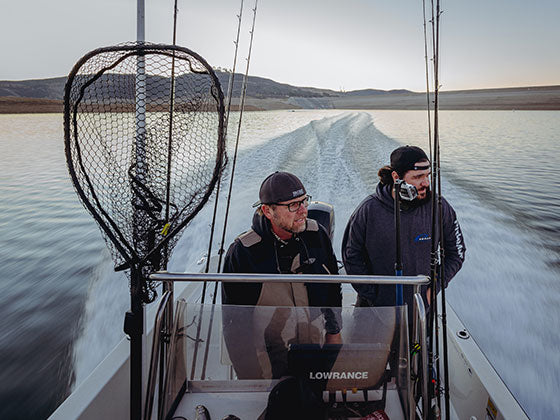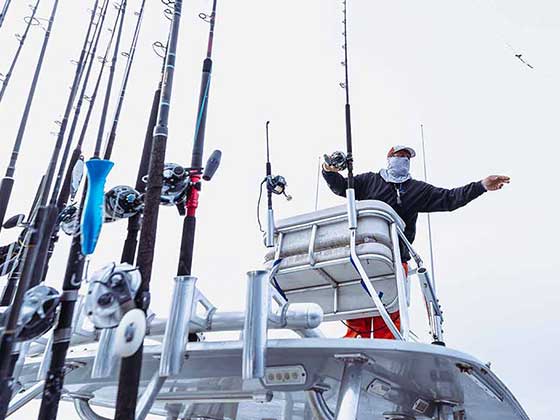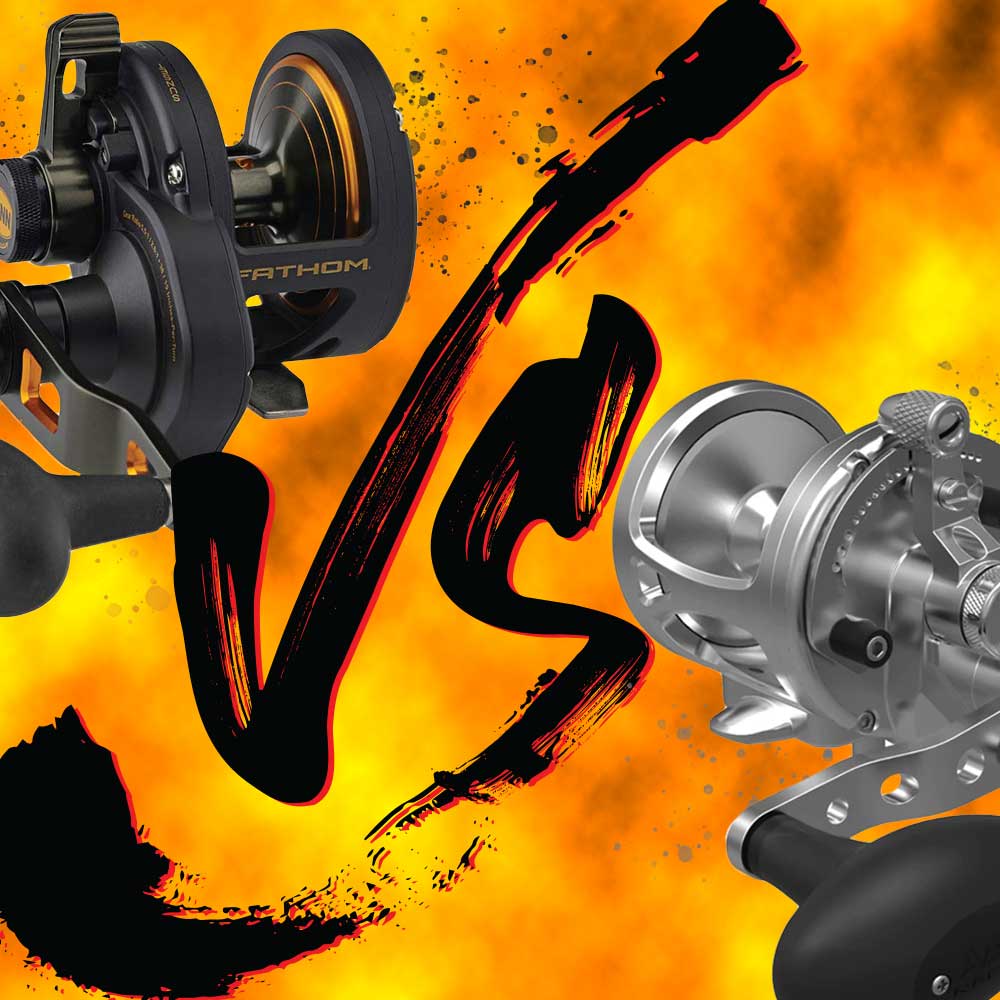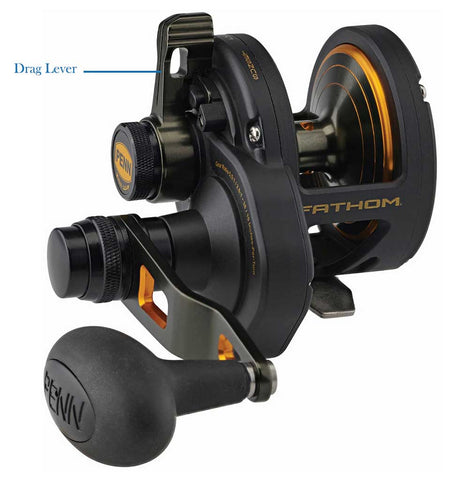Should I go with a Penn Fathom 2-Speed or an Avet 2-Speed reel?
We often get asked by customers in the shop, should I go with a Penn Fathom 2-speed or an Avet 2-speed reel? That is a tough question to answer because both are great reels and will hold up to tough fighting fish. Here locally, we often use 2-speed reels to catch tuna but there is nothing wrong with having the low gear for other pelagic fish or for bottom fishing. In many cases, having options is a good thing since you never know what you will need until you really need it.
This is a tough question to answer because both are great reels and will hold up to tough fighting fish. My intention here is to review points that we consider are the five key features of each reel. This will hopefully give you a thorough comparison and help you choose the best reel for you.
*Be sure to read all the way to the end for additional helpful information.
Drag Lever
All two speeds are lever drag reels, meaning the drag switches by moving a lever forward or backward. Pushing the lever fully downwards puts the reel in free spool while moving it all the way forward engages the reel’s max drag. Most lever drag reels have a push button that prevents the reel from going into full drag. The push button keeps the reel drag set at a pre-determined amount called the “strike drag” until it is depressed and pushed into full drag. Both the Penn Fathom 2-Speed and the Avet 2-Speed are lever drag reels; however, there are differences in how each one works.
Avet Lever Drag
The lever on the Avet 2-Speed has a great knurled end that provides a better grip which is great when your hands are wet or when you just got bit and need to make changes quickly. The non-Raptor versions do-not have a clicking noise or action, instead you will notice they have a subtle stop that indicates when you are in the strike drag position. Push the lever past the stop and you are at full drag. On the other hand, regular Avet reels do not have the push button. Not having the push button can cause you to accidentally put the reel in full drag mode when you only wanted to go to strike drag position. The G2 and Raptor versions have a plate on which the lever drag arm slides called a “glide plate.” The glide plate on both versions has a stop button to prevent you from accidentally going into full drag. The stop button is tucked in and small but does work well.
Penn Lever Drag
The lever drag arm on the Penn Fathom 2-Speed is smooth, sleek, and easy to move back and forth, however, it does not have the knurled grip like the Avet. Instead, the lever drag arm has ridges that work well while the push button is large and easy to get to. The lever system on these reels also makes a clicking noise and has a clicking feel to it when adjusting the drag arm; a design we appreciate.
Reel Drag
The drag is one of the most talked about aspects of a reel, mainly because it helps use gauge a reel’s quality. Most 2-speed reels have more drag than you will ever need but having extra drag is not a terrible thing. The reel’s drag is typically set to one-third of the line strength. For example, if you are using 30-pound line, you would set your strike drag to 10 pounds. Additionally, the amount of drag your reel has along with its line capacity, will determine the reel you need. If you are fishing for 100-pound tuna you should not choose a reel with 15 pounds of max-drag which holds 300 yards of 30-pound line.
Avet Drag System
Avet reels have a great drag system that is smooth right out of the box. The carbon fiber drag washers are durable, can take a tremendous amount of heat, and work well in all conditions. Most reels these days come with carbon fiber drags, what sets Avet reels apart is found in the Raptor series. The Raptor Series reels have more drag for the reel size compared to most of its competitors; this is due to a double thick main drag washer which is notched and glued to the spool. This feature prevents the drag washer from turning under extreme pressure and acts as a dual drag system.
Penn Drag System
For the price, the Penn Fathom offers the best bang for your buck when it comes to drag. These reels also have carbon fiber drag washers called Dura-Drag which we found to be slightly smoother than competing brands right out of the box. Unlike the Avet, there is only one version of the Fathom and therefore you cannot upgrade to a model with more drag. While the Fathom has more drag than the base model and Avet G2 reels, the Avet Raptor beats them all.
Bearings
The quality of the bearings in your reel as well as the location is more important than how many bearings are in a reel. If a reel has high quality bearings in the all the right places, it can feel smoother and better free spool compared to a reel with a lot of subpar bearings placed incorrectly. Both the Penn Fathom 2-Speed and the Avet 2-Speed reels mentioned here have well placed bearings. The main difference is that one has more than the other.
Avet Bearings
Most Avet reel have 8 bearings while the raptor has 9 which is remarkable for a 2-Speed saltwater These stainless-steel bearings in the Avet will resist corrosion as long as they are properly maintained and serviced. The reel runs smoothly and feels to get smoother with use. While it is not butter-smooth, it does make up for it in durability and dependability. To thoroughly clean the reel, Avet recommends submerging the reel in freshwater for one to two minutes and turning the handle twice underwater. This is the only reel that we recommend doing this with, which speaks to its quality build.
The bearings on the spool often decide the castability and free spool capabilities (spinning the spool when the drag is not engaged) of a reel. Out of the box, the spool of the Avet reels spins easily on free spool but only briefly. Depending on your casting experience, you may find this will help you prevent backlashes. Additionally, the optional MC Cast cast control knob allows you to further fine tune your reel. You want to consider that a backlash could put your reel out of commission for the rest of your trip. With any new reel, we recommend practicing your casting until you feel comfortable enough to take it on your next fishing trip.
Penn Bearings
For only having 5 bearings, the Penn Fathom feels extremely smooth. Penn uses high-quality stainless-steel bearing placed in all the right places. The spool performs so smooth that you may think it is made with more than 5 bearings given free spool on this reel is outstanding and the proficient angler will have no issues casting with ease. On the other hand, inexperienced anglers may find the smooth free spool frustrating without practice. We have found the best way to keep your bearings spinning is to lightly rinse the reel in warm water or spray it down with the hose. Be careful not to force water into the Penn Fathom, just get the line and outside of the reel wet.
2 Speed Buttons
The two-speed button is what you use on 2-Speed Reels to engage the low or high gears and each reel has a slightly unique way of doing this. To switch speed, you must have the drag engaged or what we call “in-gear.” Simply make the change then turn the handle to activate, doing so will switch the reel into the gear you wish. High gear is where you normally keep your reel, especially at the beginning of fighting a fish. After the fish tires and starts doing circles closer to the boat, it is time to switch to low gear.
Once you click it into low you can really start winching the fish back to the boat. It helps to set the rod on the rail when you turn the handle. If you are in a private skiff, set the rod on your knee or lean back in your fighting belt and crank the fish in. Setting your reel in low gear brings in the fish slower but makes it easier to crank the handle. We also like to use the low gear when bottom fishing at deep depths of two hundred feet or more. Having 8-16 ounces of weight with a couple fish on your hooks makes it difficult to wind your catch back with a high gear reel.
Avet 2 Speed Buttons
The Avet 2-Speed has an effective small outer button for going into low gear and an equally sized push lever for going into high gear. Switching gears is easy to do, however, the high gear button does protrude from the spool quite a bit which I can see it getting damaged if it were to hit a firm surface. Nonetheless, the push button is remarkably effective, and most anglers are ok with the configuration.
Penn 2 Speed Buttons
We love the large push button to go into low gear on the Penn 2 Speed reel. It is easy to find, easy to push, with a flush wide design, a winner. The knurled high gear toggle is engaged by turning it clockwise and works with ease. It is flawless, easy to use, and has no down sides.
Reel Handle
The most used part of any reel is the handle and we are picky with our reel handles. For us, a reel handle must be comfortable, durable, not too large, nor too small, and should have be the right length. We appreciate it when the handle knob has grip, especially when you have bait slime and wet hands. It is important that the length of the handle is not too short since this will reduce the torque and thus make it more strenuous on the angler. On the other hand, if the handle is too long, it may feel cumbersome as well as awkward.
Avet Handles
We love the feel of the Avet handle, it has a soft grip feel to it that keeps your hand connected. One downside to the soft knob we noticed when putting line on at the shop with the machine. On occasion, the knob may start to show signs of wear caused by the friction of the lever that turns the reel handle.
The length on the Avet reel is perfect with the right feel you need to put pressure on the fish while feeling comfortable when turning the handle quickly. If you want a bigger handle, the HXW T-Bar handle is a good option which will fit on the JX, LX and all the HX models. We only recommend replacing the handle if you are targeting bigger fish or are using deep drop knife jigs for big tuna. The larger HXW T-Bar handle makes fishing both techniques far more comfortable.
Penn Handles
The handle length of the Penn reel is perfect and will feel great when fighting a fish. The knob on the handle is constructed of a harder material which can get slippery when wet or when you have fish slime on your hands. The Penn handle stands up well to the line machine at the shop and we have never seen signs of damage after spooling these reels up. As far as we are aware, there are no bigger replacement handle options for this reel. From the Fathom 15 size to the 60 size, they all have the same size handle.
Conclusion
There you have it. Other than internal components, we think these 5 features are the most important to keep in mind when choosing between both reels. There are other aspects to consider as well. We recommend you look up the drag specs, line capacity, and price to help you make the right decision for you. All of us at the Shop would fish either one of these reels with confidence. Both reels are available in-store as well as online with only positive feedback from our customer who fish them. The reels will last you an exceptionally long time, especially when properly maintained.
We hope you found this information helpful. If you are still having a tough time choosing a 2-Speed reel to fit your needs, feel free to swing by our retail store in Santa Clarita, CA or contact us online.
Youtube watcher Soul wrote some additional great information about both reels. Check out our Youtube video and his comments below. If you have additional comments that you think would be helpful to others, please send them to info@tackleexpress.com
There are a few huge things to clarify between the two. First: the drag itself on the Avet Raptors is a much better design than the fathoms, it has 2 plates that pushes from both sides of the carbon washer which reduces load on the pinion allowing higher drag settings without much side load. The fathoms drag is a pull system which is pretty much the staple design on lever drags, it will get a bit more side load than the raptors and not as much drag, but is very reliable and proven.
Two: Bearings, the fathom utilizes a thrust bearing on the belleville side of the reel, this was incorporated to reduce side load by reducing axial load, but honestly it doesn't seem to make much of a difference, it does take a lot of the axial load off the spool bearings though so the pinion does most of the work as it should. The Avet raptors utilize an oversized spool bearing on the same side, which handles axial load better than a standard size spool bearing. It does the job more effectively, much less noticeable side load while cranking.
Another important thing to consider is the anti reverse, the avet uses one dog which is activated with a "arm" attached to the gears which moves back and forth with the handle. Its pretty reliable but i have seen the ratchet teeth snap off since its more load on each tooth with one dog. The fathom uses double ambassador style dogs with "arms" on the dog itself that grips the ratchet. This is pretty much the staple anti reverse design which hardly ever fails. It also catches much faster than a single dog since there are 2 and there is no chance of slipping, also providing less playback.
The MC design on the avet is also a pretty controversial feature, it would have been far better suited on a star drag since lever drags aren't the ideal casters, in the west coast fishery we usually use live bait for bluefin and the magnets can restrict the bait making it swim less naturally. I have taken a step back from the fathoms, even though they have caught plenty of fish for me and hardly ever failed, I find the best performance in the new Shimano Speedmasters which are unbelievably underrated, out of the box the fathoms overall preform better, achieving much more drag much easier than the fathoms. Only issue is out of the box performance which has poor free-spool, but if you open the spool bearings and lube them with TSI 321 you got a very nice reel.
Anyways, In this review the raptor takes the lead in performance but the fathom is better suited all around for west coast anglers.











